Oxford English 5B Module2 Unit1 Animals I like 教学案例
- 格式:doc
- 大小:39.50 KB
- 文档页数:5
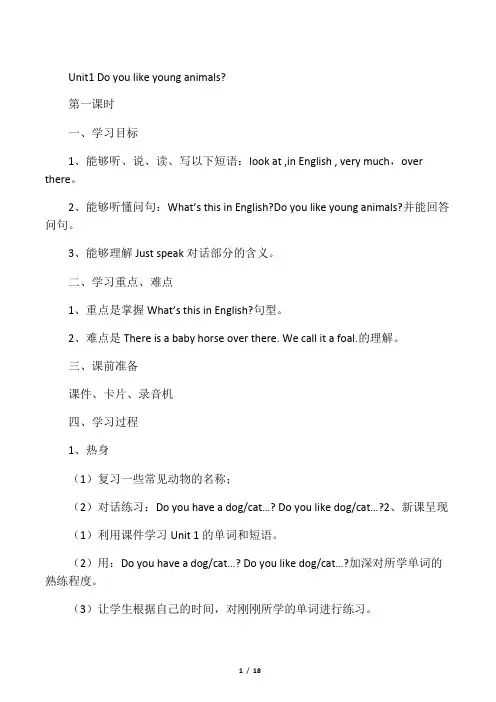
Unit1 Do you like young animals?第一课时一、学习目标1、能够听、说、读、写以下短语:look at ,in English , very much,over there。
2、能够听懂问句:What’s this in English?Do you like young animals?并能回答问句。
3、能够理解Just speak对话部分的含义。
二、学习重点、难点1、重点是掌握What’s this in English?句型。
2、难点是There is a baby horse over there. We call it a foal.的理解。
三、课前准备课件、卡片、录音机四、学习过程1、热身(1)复习一些常见动物的名称;(2)对话练习:Do you have a dog/cat…? Do you like dog/cat…?2、新课呈现(1)利用课件学习Unit 1的单词和短语。
(2)用:Do you have a dog/cat…? Do you like dog/cat…?加深对所学单词的熟练程度。
(3)让学生根据自己的时间,对刚刚所学的单词进行练习。
(4)介绍重点句型:What’s this in English? Do you like young animals?……(5)组织学生模仿上列句型进行对话。
(6)利用演示对话,并让学生进行模仿练习。
(7)学生二人一组配合课件演示对话,逐步熟悉对话内容,重点掌握What’s this in English?句型和理解领会There is a baby horse over there. We callit a foal.的含义。
(8)帮助学生理解本部分内容。
引导学生在句子中猜测单词lookat,inEnglish , very much,over there的意思3、趣味练习Let’s read and chant4、课堂评价教师指导学生完成本课的小练习册,然后进行评价。
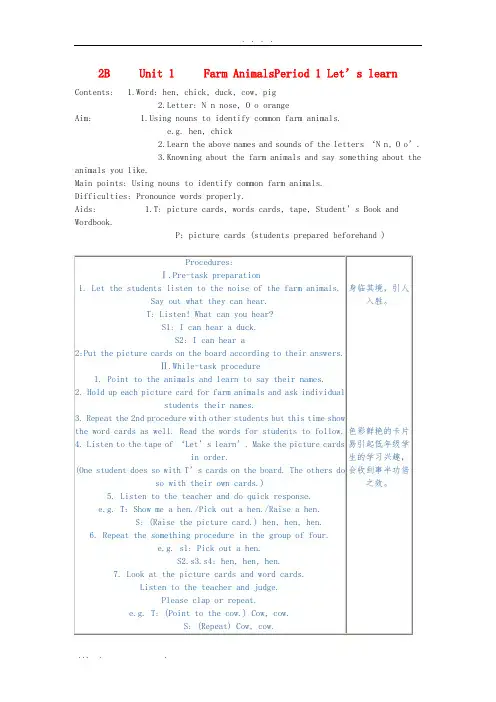
2B Unit 1 Farm AnimalsPeriod 1 Let’s learnContents: 1.Word: hen, chick, duck, cow, pig2.Letter: N n nose, O o orangeAim: ing nouns to identify common farm animals.e.g. hen, chick2.Learn the above names and sounds of the letters ‘N n, O o’.3.Knowning about the farm animals and say something about the animals you like.Main points: Using nouns to identify common farm animals.Difficulties: Pronounce words properly.Aids: 1.T: picture cards, wor ds cards, tape, Student’s Book and Wordbook.P: picture cards (students prepared beforehand )Period 2 Let’s talkContents: What do you see? I see┄What do you hear? I hear┄Aims: 1. Asking ‘wh’ questions to find out specific information about a farm.e.g. What do you see /hear?2.Using the simple present tense. e.g. I see/hear a duck.Main Points: Asking and answering the ‘wh’ questions.Difficulties: Using the models to communicate with other learners.Aids: the wallchart for page 3, six picture cards and six word cards ,tape , Student’s Book and WorkbookPeriod 3 Let’s actContents: Draw the cow on the paper. Draw the duck on the ground.Aims: ⒈ Using imperatives to give simple instructions. e.g. Draw the cow on the paper.⒉ Locating specific information in response to simple instructions.⒊ Using modeled phrases to communicate with other learners.Main points: Using imperatives to give simple instructions.Difficulties: Using modeled phrases to communicate with other learners.Aids: plain sheets of paper, toy animals, animal picture cards, tape, Workbook,Period 4. Let’s play.Contents: Listen, tick and say: I hear a…Aims: ⒈ Using the simple present tense to indicate what you hear. e.g. I hear a sheep.2. Using nouns to refer to farm animals. e.g. cowMain points: Using the simple present tense to indicate what you hear. Difficulties: Recognizing key words of the animals.Aids: Student’s Book and Workbook, tape, word and picture cardsPeriod 5 Let’s enjoy.Contents: story: I’ve got a cow. It goes ‘moo, moo’.Aims: ⒈ Using formulaic expressions to indicate possessions. e.g. I’ve got a cow.⒉ Using formulaic expressions to indicate what noise animals m ake. e.g. It goes ‘moo, moo’.Main points: Using formulaic expressions to indicate possessions and what noise animals make.Difficulties: Pronounce correctly words in connected speech by linking together and using appropriate stress.Aids: Student’s Book, tape, a toy animal。
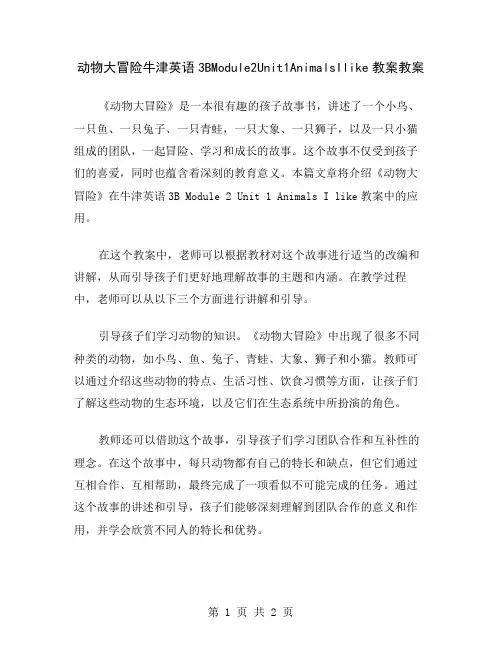
动物大冒险牛津英语3BModule2Unit1AnimalsIlike教案教案《动物大冒险》是一本很有趣的孩子故事书,讲述了一个小鸟、一只鱼、一只兔子、一只青蛙,一只大象、一只狮子,以及一只小猫组成的团队,一起冒险、学习和成长的故事。
这个故事不仅受到孩子们的喜爱,同时也蕴含着深刻的教育意义。
本篇文章将介绍《动物大冒险》在牛津英语3B Module 2 Unit 1 Animals I like教案中的应用。
在这个教案中,老师可以根据教材对这个故事进行适当的改编和讲解,从而引导孩子们更好地理解故事的主题和内涵。
在教学过程中,老师可以从以下三个方面进行讲解和引导。
引导孩子们学习动物的知识。
《动物大冒险》中出现了很多不同种类的动物,如小鸟、鱼、兔子、青蛙、大象、狮子和小猫。
教师可以通过介绍这些动物的特点、生活习性、饮食习惯等方面,让孩子们了解这些动物的生态环境,以及它们在生态系统中所扮演的角色。
教师还可以借助这个故事,引导孩子们学习团队合作和互补性的理念。
在这个故事中,每只动物都有自己的特长和缺点,但它们通过互相合作、互相帮助,最终完成了一项看似不可能完成的任务。
通过这个故事的讲述和引导,孩子们能够深刻理解到团队合作的意义和作用,并学会欣赏不同人的特长和优势。
教师还可以引导孩子们学习生命的尊重和保护。
在这个故事中,动物们的生命得到了保护和尊重,并在冒险过程中不断学习和成长。
教师可以通过引导孩子们了解动物的生命价值,以及它们在生态系统中所起的作用,让孩子们养成保护动物、尊重生命的良好习惯和价值观。
在教学过程中,教师还可以结合不同的教学手段和活动,如游戏、绘画、互动等,培养孩子们的学习兴趣和积极性。
例如,可以根据不同的故事情节,进行角色扮演、剪纸、讲故事等活动,让孩子们更好地理解和掌握故事的主题和内涵。
通过《动物大冒险》这个故事,教师可以引导孩子们学习动物知识、团队合作和互补性的理念,以及生命的尊重和保护。

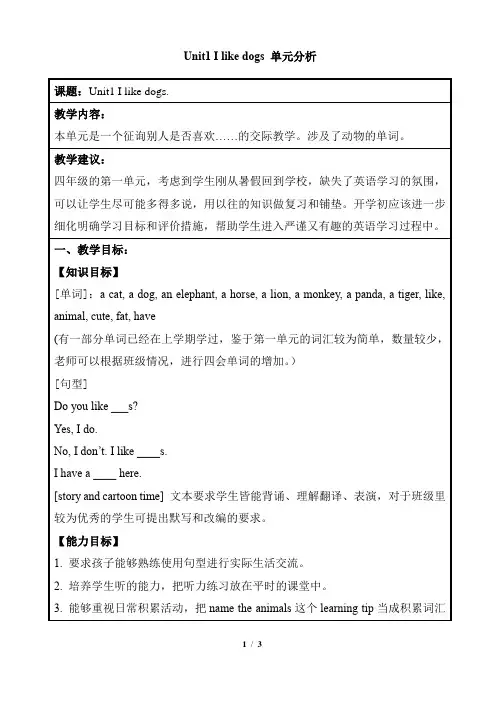
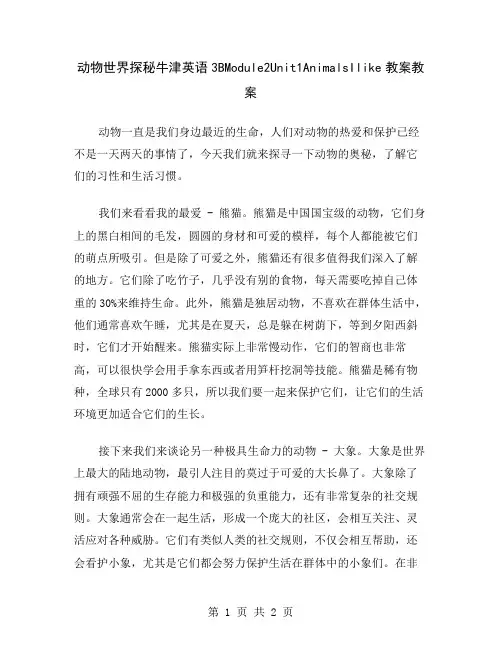
动物世界探秘牛津英语3BModule2Unit1AnimalsIlike教案教案动物一直是我们身边最近的生命,人们对动物的热爱和保护已经不是一天两天的事情了,今天我们就来探寻一下动物的奥秘,了解它们的习性和生活习惯。
我们来看看我的最爱 - 熊猫。
熊猫是中国国宝级的动物,它们身上的黑白相间的毛发,圆圆的身材和可爱的模样,每个人都能被它们的萌点所吸引。
但是除了可爱之外,熊猫还有很多值得我们深入了解的地方。
它们除了吃竹子,几乎没有别的食物,每天需要吃掉自己体重的30%来维持生命。
此外,熊猫是独居动物,不喜欢在群体生活中,他们通常喜欢午睡,尤其是在夏天,总是躲在树荫下,等到夕阳西斜时,它们才开始醒来。
熊猫实际上非常慢动作,它们的智商也非常高,可以很快学会用手拿东西或者用笋杆挖洞等技能。
熊猫是稀有物种,全球只有2000多只,所以我们要一起来保护它们,让它们的生活环境更加适合它们的生长。
接下来我们来谈论另一种极具生命力的动物 - 大象。
大象是世界上最大的陆地动物,最引人注目的莫过于可爱的大长鼻了。
大象除了拥有顽强不屈的生存能力和极强的负重能力,还有非常复杂的社交规则。
大象通常会在一起生活,形成一个庞大的社区,会相互关注、灵活应对各种威胁。
它们有类似人类的社交规则,不仅会相互帮助,还会看护小象,尤其是它们都会努力保护生活在群体中的小象们。
在非洲,大象被视为象征着智慧和神圣的动物。
但是因为非法猎杀和森林开发等原因,大象们正面临很大的危险,所以我们也要一起努力保护它们,让它们的生活环境得到改善和保护。
我们谈一谈吉祥物和宠物 - 猫和狗。
猫和狗是人类喜欢的最常见的宠物,它们可以是我们的伴侣、朋友,甚至是救星。
它们都是非常聪明、机灵,能够识别人类的情感。
与此同时,它们也有自己独特的行为和语言习惯,如猫会用尾巴表达情感,而狗会用眼神传达感觉。
众所周知,狗是一个忠诚、勇敢、又谨慎的动物,对主人极尽忠诚。
而猫则比较喜欢独立,不过它也非常善于照顾主人和它们共处的家,猫还是一个“干净”的动物,它们经常用自己的舌头清理自己的身体和毛发。
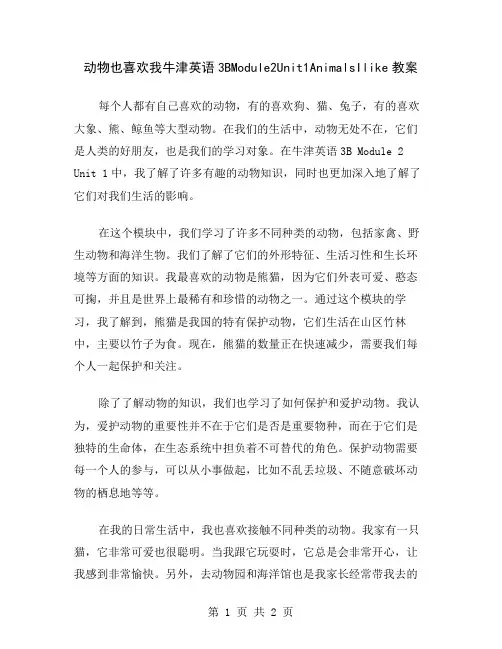
动物也喜欢我牛津英语3BModule2Unit1AnimalsIlike教案每个人都有自己喜欢的动物,有的喜欢狗、猫、兔子,有的喜欢大象、熊、鲸鱼等大型动物。
在我们的生活中,动物无处不在,它们是人类的好朋友,也是我们的学习对象。
在牛津英语3B Module 2 Unit 1中,我了解了许多有趣的动物知识,同时也更加深入地了解了它们对我们生活的影响。
在这个模块中,我们学习了许多不同种类的动物,包括家禽、野生动物和海洋生物。
我们了解了它们的外形特征、生活习性和生长环境等方面的知识。
我最喜欢的动物是熊猫,因为它们外表可爱、憨态可掬,并且是世界上最稀有和珍惜的动物之一。
通过这个模块的学习,我了解到,熊猫是我国的特有保护动物,它们生活在山区竹林中,主要以竹子为食。
现在,熊猫的数量正在快速减少,需要我们每个人一起保护和关注。
除了了解动物的知识,我们也学习了如何保护和爱护动物。
我认为,爱护动物的重要性并不在于它们是否是重要物种,而在于它们是独特的生命体,在生态系统中担负着不可替代的角色。
保护动物需要每一个人的参与,可以从小事做起,比如不乱丢垃圾、不随意破坏动物的栖息地等等。
在我的日常生活中,我也喜欢接触不同种类的动物。
我家有一只猫,它非常可爱也很聪明。
当我跟它玩耍时,它总是会非常开心,让我感到非常愉快。
另外,去动物园和海洋馆也是我家长经常带我去的地方。
在那里,我可以看到各种各样的动物,如老虎、大象、海豚、鲸鱼等等。
这些动物的,远比看图片和视频更让人有身临其境的感觉,也更能够深入地理解它们每一种形态和习性。
动物是一个很大、也很有趣的话题。
我们平时接触到的各种动物,不仅可以带来快乐,也可以提高我们的环保意识。
希望在未来的学习中,我可以更加深入地了解各种动物,并在日常生活中做出更多的环保贡献。
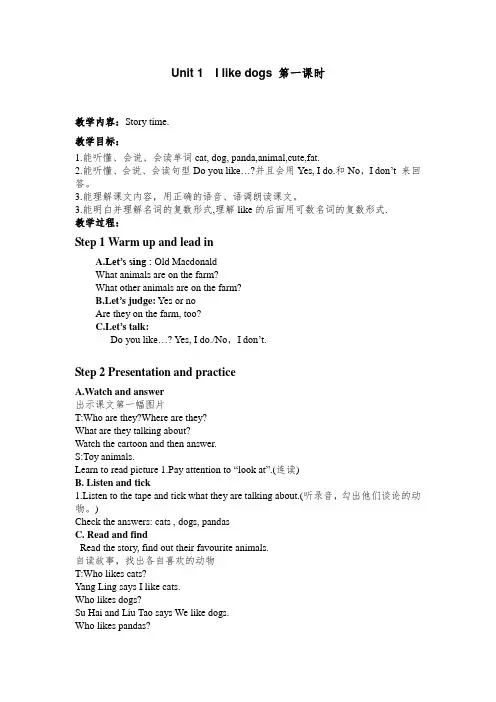
Unit 1 I like dogs 第一课时教学内容:Story time.教学目标:1.能听懂、会说、会读单词cat, dog, panda,animal,cute,fat.2.能听懂、会说、会读句型Do you like…?并且会用Yes, I do.和No,I don’t 来回答。
3.能理解课文内容,用正确的语音、语调朗读课文。
3.能明白并理解名词的复数形式,理解like的后面用可数名词的复数形式.教学过程:Step 1 Warm up and lead inA.Let’s sing : Old MacdonaldWhat animals are on the farm?What other animals are on the farm?B.Let’s judge: Yes or noAre they on the farm, too?C.Let’s talk:Do you like…? Yes, I do./No,I don’t.Step 2 Presentation and practiceA.Watch and answer出示课文第一幅图片T:Who are they?Where are they?What are they talking about?Watch the cartoon and then answer.S:Toy animals.Learn to read picture 1.Pay attention to “look at”.(连读)B. Listen and tick1.Listen to the tape and tick what they are talking about.(听录音,勾出他们谈论的动物。
)Check the answers: cats , dogs, pandasC. Read and findRead the story, find out their favourite animals.自读故事,找出各自喜欢的动物T:Who likes cats?Yang Ling says I like cats.Who likes dogs?Su Hai and Liu Tao says We like dogs.Who likes pandas?Mike says I like pandas.(Tip:表达喜欢某一类东西时,用like+复数(—s))D. Read and circleT:Read picture 2,3,4 and circle like this.In picture 2,what do you circle? Teach “cute”How about picture 3?What about picture 4?Why does Mike like pandas?Because they are cute and fat.教授单词cute(可爱的,机灵的)fat (胖的) at,cat,fat,让学生自己拼读单词。
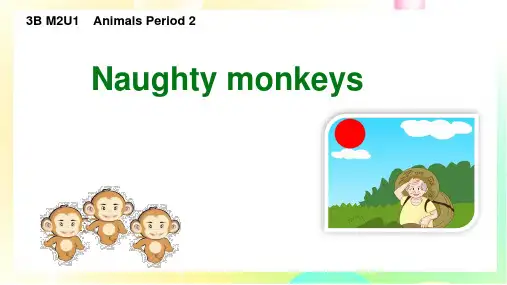
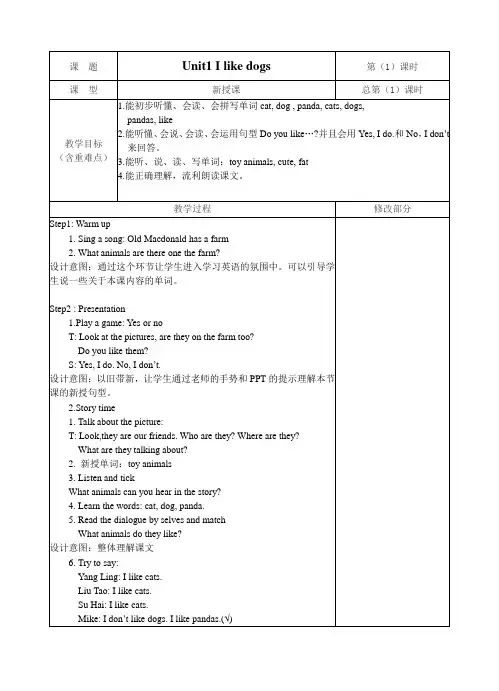
Oxford English 5B Module2 Unit1 Animals I like 教学案例 本课是牛津英语教材(上海版)五年级第二学期Module 2 Unit 1的一篇课文。基于牛津英语教材的编写特点:task based learning,本课是在上学期Wild Animal一课的基础上的进一步学习,主要是通过zoo-keeper的timetable来了解他的早晨工作以及动物们的进食情况。由于本课的学习主题(subtopic)是学生较感兴趣的话题animals,所以学生有较强的学习愿望和兴趣。我以talking about the animals为主题,把学生的英语思维训练作为本课设计的主旨,试图通过一系列的活动进一步培养和提高学生的英语思维能力。在平时的英语课堂活动中学生以机械性的操练为主,学生很少主动地、积极的用英语思维,把语言与思维的关系割裂开来,其实思维和语言有着直接的关系并对掌握一门语言有着重要的影响。在本课中我设计的一系列的语言交际活动都是力求通过学生的创造性思维活动(learning by thinking),突出语言学习的意义,帮助学生综合性的运用语言,从而提高英语的交际能力。 二 教学目标分析 1. 教学内容 1)单词:kilo 2)句型:How much „ do „eat?及其回答 2.预设目标 基本目标: 1) 学生能四会掌握单词kilo 2) 学生能四会掌握句型:How much„.do„. eat ? 及其回答 3) 学生能够掌握elephant tiger parrot 和monkey 的进食情况。 4) 学生能够了解zoo-keeper早晨的工作。 发展目标: 1) 学生能够对zoo-keeper的工作进行猜测和表述。 2) 学生能就提供的语言素材进行合理有序的问答练习。 3) 学生能用第三人称介绍Steven Brown的早晨工作,并能介绍家人,朋友的生活和工作情况。 3学生情况分析: 本班的学生通过五年的牛津英语的学习,在语言的表达方面有较高的能力,擅长综合性的运用语言进行不同事物的介绍。就本课的学习内容来说,学生已经能够从各方面对一些动物进行描述:(包括颜色、大小、喜欢的食物,习性等等),学生还能就一幅或几幅图进行合理的想象、介绍和描述。此外,学生自编对话的能力也较强,能够就各种提供的素材进行自编对话的练习。
三 教学策略分析 1 运用开放性的问题,帮助学生进行合理的英语思维。 2 利用猜测与想象的方法,提高学生的英语思维能力。 3 发散性思维与收敛性思维相结合,培养学生的创造性思维能力。 四 教学片段: Pre-task preparation T:Daily talk: What’s your favourite zoo animal? (学生以4人小组为单位进行讨论) P1:Monkeys are my favourite zoo animal. They are brown. They are lovey. They like to swing and climb. They like to eat bananas. I love them every much. P2:I like lions best. They are big and strong. They like to eat meat. They are the kings of the forest. (在课前的热身活动中,通过介绍自己最喜欢的动物,自然的引入本课的学习,它既是对学生已有知识的整合,也是为新课的教学做好了铺垫。)
While-task procedure
1) T:Please look at these animals and match the food they like. (学生连线,把动物和他们喜欢的食物配对) T:How much meat do tigers eat? P:They eat 10kilos of meat. (它既是free talk 内容的延续和拓展,又巧妙的引入新单词:kilo的教学。) 2)T:(Show five interesting pictures) Please look at these pictures and say sth about them. (学生以2人小组的形式进行讨论) P:Look at this monkey . It is lovely. It can swing on the tree. It can make faces. Bananas are his favourite food. Now he is eating a banana. Look, this is a baby monkey. It is small. The zoo-keeper is feeding the baby monkey. (这个教学设计提供给学生真实的语言素材,给学生充分的思维空间,利用不同的图片和素材内容,帮助学生进行英语思维,激发学生说英语的愿望,提高学生的英语思维能力。) 3) T: Look, he is Mr Tang. He is a zoo-keeper. Now let’s do role-play.:I’m Mr Tang. I’m a zoo-keeper. P: I’m Mr Tang. I am a zoo-keeper. Everyday I feed the animals and clean their cages. And I often play with them and take a shower with them. I love animals very much and they love me too. We are good friends. (这个练习利用猜测与想象的方法,让学生对所给人物的工作和生活进行合理的推断,帮助学生在一个合理的情境中进行思维和语言的训练,更有助于学生语言能力的培养和提高。) Post-task procedure T:(出示Steven Brown’s timetable)He is Steven Brown. He is a farmer. Please look at his timetable and introduce it. If you don’t like his timetable, and you can make a new one. And you also can introduce your friend’s or your family member’s timetable. P1: Talk about Steven Brown’s timetable. P2: Talk about the new Steven Brown’s timetable. P3: Talk about his good friend’s timetable. P4: Talk about her father’s timetable. (这个综合性的语言训练,在呈现一部分语言素材的基础上,让学生积极思维,发挥想象,留给学生一定的思维和创作空间。学生也可以结合自己感兴趣的内容进行人物、时间和事物的替换练习,能进一步激发学生的求知欲,帮助学生进行知识的迁移和运用,提高学生综合性的语言运用能力。) 总之,学生的英语思维能力的培养是一个循序渐进的过程,教师只有在教学设计和课堂教学的过程中时刻关注学生的学习体验,注意多角度、多方位设计各种思考题,发挥学生横向、类比、逆向联想等思维,使学生不单单是理解和掌握所学的内容,而是利用现有经验,结合已学知识去创造、去探索,培养创新思维能力,才能使学生的语言输出更丰富。 名称: 《5BM2U1Animals in the zoo 教学案例》 学年:2008 一、有关背景: 本教学案例是上海版小学牛津英语5B中的M2U1Animals in the zoo一课。本堂课主要是让学生掌握单词kilo, 词组____ kilo(s) of ____和句型How much ____ does/do the ____ eat? It eats/They eat ____ kilo(s) ____.并且拓展了单词kilogram以及句型How many kilos of „? 通过学习,让学生能应用所学单词和句型对自己喜爱的动物的形态、饲养方面的知识进行提问与表达。并且能了解动物的一些知识,使学生对动物产生兴趣,产生去了解的渴望,然后使学生由衷地产生要保护动物的意识。 二、教学实录: 通过问学生“Which zoo animal do I like?”来引出lion,然后由学生说的“The lion is very heavy.”引出新授单词weight、kilo和kilogram。在单词的教学中,我先出示音标,让学生自己去根据音标拼读单词,然后进行指导。这样,既体现了学生的自主性,又提高了学生语音学习的能力。在操练weight和kilo时,我让学生说说The lion’s weight is about ____ kilos. My weight is about ____ kilos.让学生在句子中操练单词,遵循了词不离句的原则。而且通过lion的体重和学生体重的比较,让学生说说Why is the lion so heavy?通过学生的回答“It likes to eat meat.”“It eats much meat every day.”来引出新句型 How much meat does the lion eat every day?和词组____ kilo(s) of ____。在操练词组时,我遵循了由易到难,循序渐进的原则。先是用多媒体出示各种动物食物的图片,让学生说说食物的重量,然后让他们跳出老师给的框框,自己去组词,如one kilo of water,two kilos of bananas等词组。这样,充分调动了学生的积极性,使他们牢固掌握了新知识,也为句型的学习打下了扎实的基础。在进行How much ____ does/do the ____ eat? It eats/They eat ____ kilo(s) ____.的对话操练时,我采用了pair work的形式,让他们根据屏幕上的图片自由选择地说一说。 由于对新词组和新句型进行了高密度的操练,所以在教授拓展句型How many kilos of „?时,我把主动权交给学生,先请两个能力较强的学生进行提问和回答,给其他学生做好示范,然后再由其他学生模仿操练。这样,既体现了以学生为主体的原则,又激发了学生主动学习的兴趣。